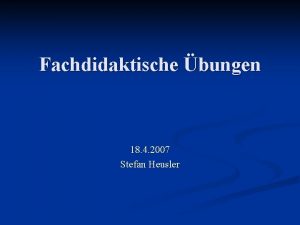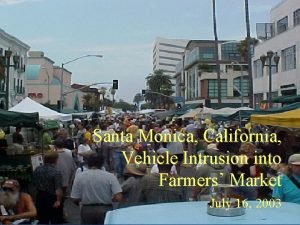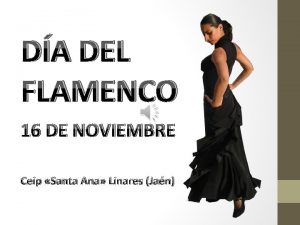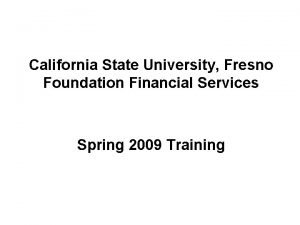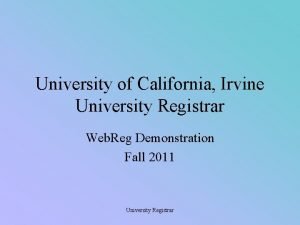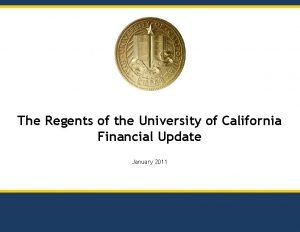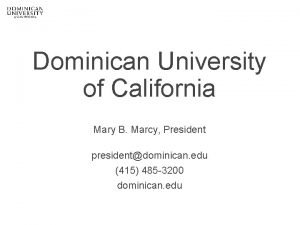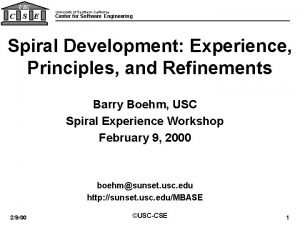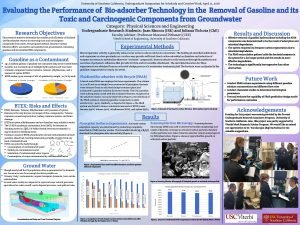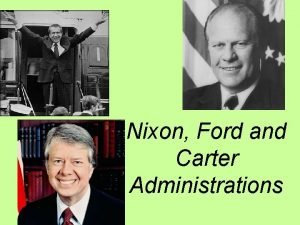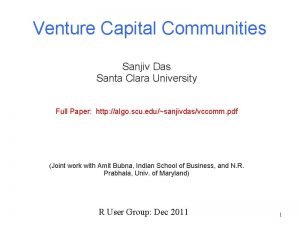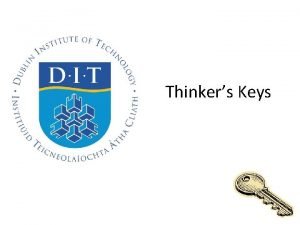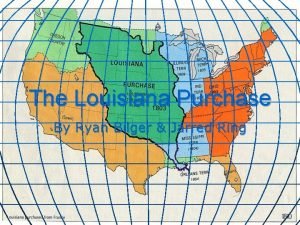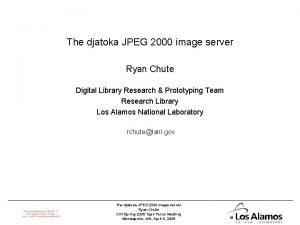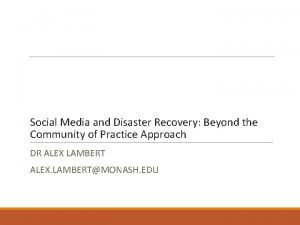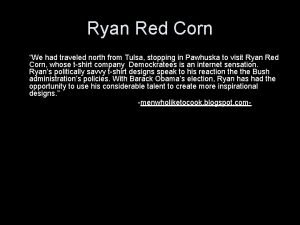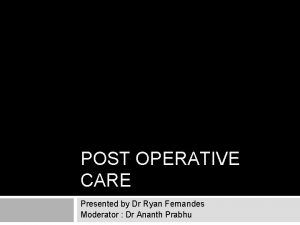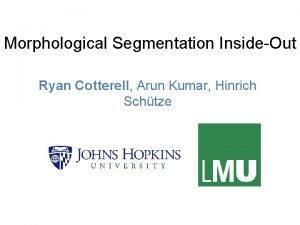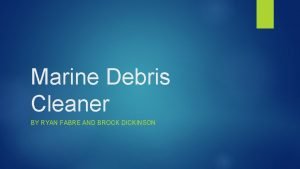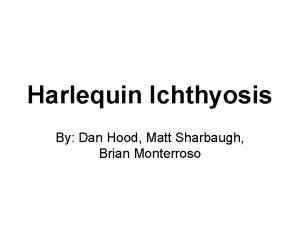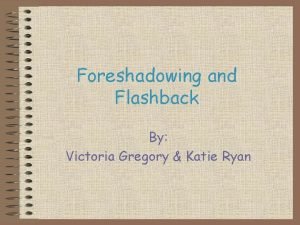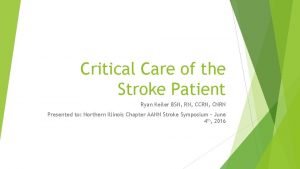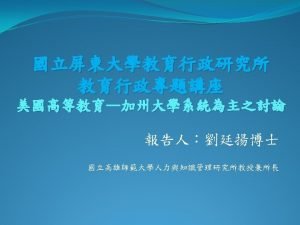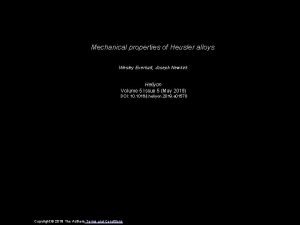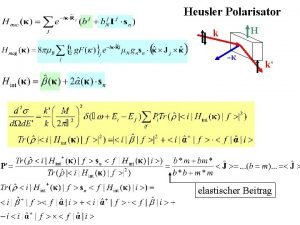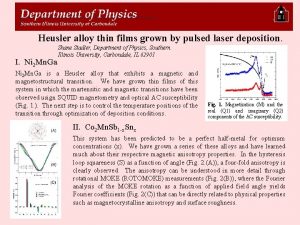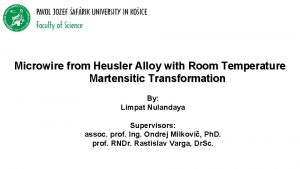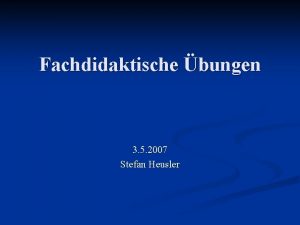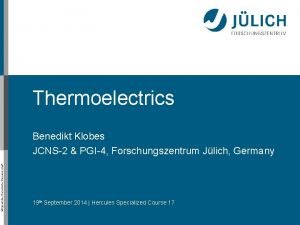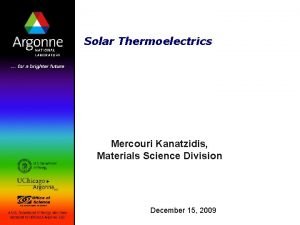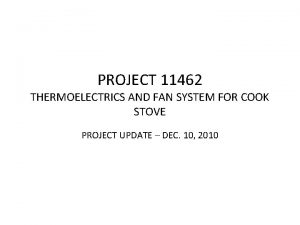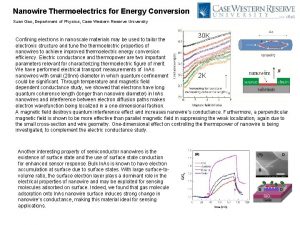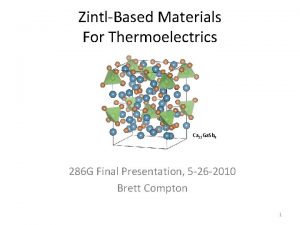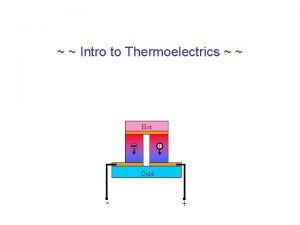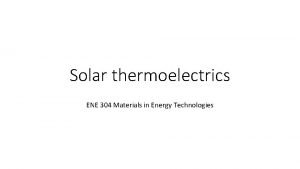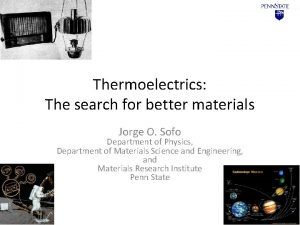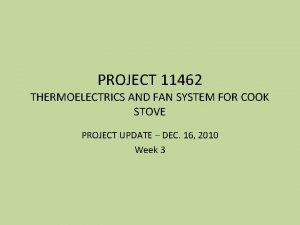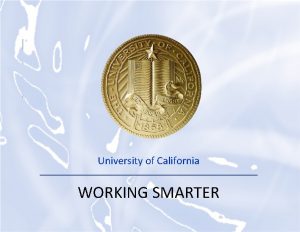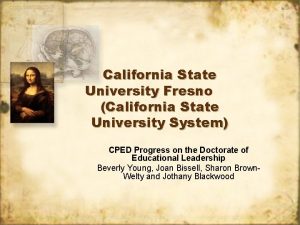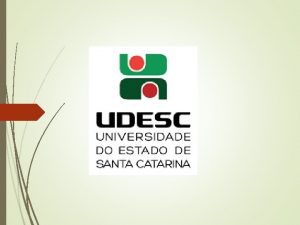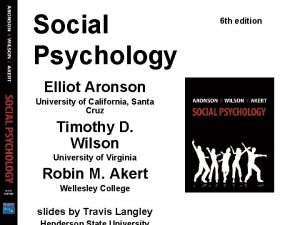Heusler Thermoelectrics RYAN NEED UNIVERSITY OF CALIFORNIA SANTA






































- Slides: 38

Heusler Thermoelectrics RYAN NEED UNIVERSITY OF CALIFORNIA SANTA BARBARA MATRL 286 G, SPRING 2014

Heusler Compounds

Half Heusler, XYZ (e. g. Ti. Co. Sb) Heusler Compounds Co Sb Ti

Half Heusler, XYZ (e. g. Ti. Co. Sb) Co Sb Heusler Compounds Ti Co Full Heusler, XY 2 Z (e. g. Ti. Co 2 Sb) Sb Ti

Thermoelectric Devices Images from: J-F Li, W-S Liu, L-D Zhao, M Zhou, High-performance nanostructured thermoelectric materials, NPG Asia Mater. 2 4 (2010) 152 -158.

Thermoelectric Devices Images from: J-F Li, W-S Liu, L-D Zhao, M Zhou, High-performance nanostructured thermoelectric materials, NPG Asia Mater. 2 4 (2010) 152 -158.

The goal of this talk… Heusler Compounds Thermoelectric Devices is to understand where these two overlap.

Points of inquiry 1. What material properties make a good thermoelectric? • Derivation of thermoelectric figure or merit, ZT • Relationships between electronic and thermal properties

Points of inquiry 1. What material properties make a good thermoelectric? • Derivation of thermoelectric figure or merit, ZT • Relationships between electronic and thermal properties 2. How do Heusler alloys meet these criteria? • Electron count rules for semiconducting behavior • Unit cell complexity and alloying for phonon scattering

Points of inquiry 1. What material properties make a good thermoelectric? • Derivation of thermoelectric figure or merit, ZT • Relationships between electronic and thermal properties 2. How do Heusler alloys meet these criteria? • Electron count rules for semiconducting behavior • Unit cell complexity and alloying for phonon scattering 3. Can we design nanostructures to improve Heusler TEs? • Nanoscale grain sizes through ball milling and SPS • Half Heusler matrix with full Heusler nanoparticles

Points of inquiry 1. What material properties make a good thermoelectric? • Derivation of thermoelectric figure or merit, ZT • Relationships between electronic and thermal properties 2. How do Heusler alloys meet these criteria? • Electron count rules for semiconducting behavior • Unit cell complexity and alloying for phonon scattering 3. Can we design nanostructures to improve Heusler TEs? • Nanoscale grain sizes through ball milling and SPS • Half Heusler matrix with full Heusler nanoparticles

What material properties do we need to consider for a thermoelectric device?

What material properties do we need to consider for a thermoelectric device? What do we want this thermoelectric device to do?

What material properties do we need to consider for a thermoelectric device? What do we want this thermoelectric device to do? To maximize output power or temperature gradient

What material properties do we need to consider for a thermoelectric device? What do we want this thermoelectric device to do? To maximize output power or temperature gradient QC QH

What material properties do we need to consider for a thermoelectric device? What do we want this thermoelectric device to do? To maximize output power or temperature gradient QC QC = QH Peltier Cooling

What material properties do we need to consider for a thermoelectric device? What do we want this thermoelectric device to do? To maximize output power or temperature gradient QC QC = QH Peltier Cooling − Joule Heating

What material properties do we need to consider for a thermoelectric device? What do we want this thermoelectric device to do? To maximize output power or temperature gradient QC QC = QH Peltier Cooling − Joule Heating − Thermal Diffusion

What material properties do we need to consider for a thermoelectric device? What do we want this thermoelectric device to do? To maximize output power or temperature gradient QC QC = QH Peltier Cooling − Joule Heating − Thermal Diffusion

What material properties do we need to consider for a thermoelectric device? What do we want this thermoelectric device to do? To maximize output power or temperature gradient QC QC = Peltier Cooling − QH Joule Heating − Thermal Diffusion

The key material properties are inversely related through carrier concentration.

The key material properties are inversely related through carrier concentration.

The key material properties are inversely related through carrier concentration. Image from: G. J. Snyder, E. S. Toberer, Complex thermoelectric materials, Nat. Mater. 7 (2008) 105 -114.

The key material properties are inversely related through carrier concentration. Image from: G. J. Snyder, E. S. Toberer, Complex thermoelectric materials, Nat. Mater. 7 (2008) 105 -114. We want a degenerate semiconductor or dirty metal with a complex lattice for optimal ZT and device performance.

Points of inquiry 1. What material properties make a good thermoelectric? • Derivation of thermoelectric figure or merit, ZT • Relationships between electronic and thermal properties 2. How do Heusler alloys meet these criteria? • Electron count rules for semiconducting behavior • Unit cell complexity and alloying for phonon scattering 3. Can we design nanostructures to improve Heusler TEs? • Nanoscale grain sizes through ball milling and SPS • Half Heusler matrix with full Heusler nanoparticles

Valence precise half Heusler compounds can be semiconductors.

Valence precise half Heusler compounds can be semiconductors. Example: Ti. Co. Sb Sb Ti Co Image from: H. C. Kandpal, C. Fesler, R. Seshadri, Covalent bonding and the nature of band gaps in some half-Heusler compounds, J. Phys. D 39 (2006) 776 -785.

Valence precise half Heusler compounds can be semiconductors. Example: Ti. Co. Sb X: Ti → Ti 4+ (Ar) Sb Ti Y: Co → Co 4 - (Ga) Z: Sb → Sb Co Image from: H. C. Kandpal, C. Fesler, R. Seshadri, Covalent bonding and the nature of band gaps in some half-Heusler compounds, J. Phys. D 39 (2006) 776 -785.

Valence precise half Heusler compounds can be semiconductors. Example: Ti. Co. Sb X: Ti → Ti 4+ (Ar) Sb Ti Y: Co → Co 4 - (Ga) Z: Sb → Sb X gives up its electrons and forms a covalent zinc-blende YZ sublattice. Co Image from: H. C. Kandpal, C. Fesler, R. Seshadri, Covalent bonding and the nature of band gaps in some half-Heusler compounds, J. Phys. D 39 (2006) 776 -785. 18 -electron half Heusler compounds are electronically identical to common III-V systems.

Atomic disorder can be used to scatter phonons by alloying on the X, Y, and Z sites. Image from: T. Graf, C. Fesler, S. S. P. Parkin, Simple rules for the understanding of Heusler compounds, Prog. Solid State Chem. 39 (2011) 150. Values from: H. Hohl, A. P. Ramirez, C. Goldmann, G. Ernst, B. Wolfing, E. Bucher, Efficient dopant for Zr. Ni. Sn-based thermoelectric materials, J. Phys. : Condens. Matter 11 (1999) 1697 -1709.

Atomic disorder can be used to scatter phonons by alloying on the X, Y, and Z sites. Heavily alloy X site with large mass contrast (XX’Ni. Sn) X: Ti → Zrx. Hfy. Ti 0. 5 κ: 9. 3 W/m. K → 3 -6 W/m. K Image from: T. Graf, C. Fesler, S. S. P. Parkin, Simple rules for the understanding of Heusler compounds, Prog. Solid State Chem. 39 (2011) 150. Values from: H. Hohl, A. P. Ramirez, C. Goldmann, G. Ernst, B. Wolfing, E. Bucher, Efficient dopant for Zr. Ni. Sn-based thermoelectric materials, J. Phys. : Condens. Matter 11 (1999) 1697 -1709.

Atomic disorder can be used to scatter phonons by alloying on the X, Y, and Z sites. Heavily alloy X site with large mass contrast (XX’Ni. Sn) X: Ti → Zrx. Hfy. Ti 0. 5 κ: 9. 3 W/m. K → 3 -6 W/m. K Lightly dope on the Z site to introduce carriers (XX’Ni. Sn: Sb) Z: Sn → Sn 1 -δSbδ σ: 100 S/cm → 1200 S/cm Image from: T. Graf, C. Fesler, S. S. P. Parkin, Simple rules for the understanding of Heusler compounds, Prog. Solid State Chem. 39 (2011) 150. Values from: H. Hohl, A. P. Ramirez, C. Goldmann, G. Ernst, B. Wolfing, E. Bucher, Efficient dopant for Zr. Ni. Sn-based thermoelectric materials, J. Phys. : Condens. Matter 11 (1999) 1697 -1709.

However, phonons cover a wide range of wavelengths and require a multi-length scale scattering approach. Image from: K. Biswas, J. He, I. D. Blum, C-I Wu, T. P. Hogan, D. N. Seidman, V. P. Dravid, M. G. Kanatzidis, High-performance bulk thermoelectrics with all-scale hierarchical architectures, Nat. Lett. 489 (2012) 414 -418.

Points of inquiry 1. What material properties make a good thermoelectric? • Derivation of thermoelectric figure or merit, ZT • Relationships between electronic and thermal properties 2. How do Heusler alloys meet these criteria? • Electron count rules for semiconducting behavior • Unit cell complexity and alloying for phonon scattering 3. Can we design nanostructures to improve Heusler TEs? • Nanoscale grain sizes through ball milling and SPS • Half Heusler matrix with full Heusler nanoparticles

Nanoscale grain sizes impede mid-wavelength phonons, reduce thermal conductivity, and improve ZT. Zr 0. 5 Hf 0. 5 Co. Sb 0. 8 Sn 0. 2 Images from: X. Yan, G. Joshi, W. Liu, Y. Lan, H. Wang, S. Lee, J. W. Simonson, S. J. Poon, T. M. Tritt, G. Chen, Z. F. Ren, Enhanced thermo-electric figure of merit of p-type half-heuslers, Nano Lett. 11 (2011) 556 -560.

Half Heusler matrices with full Heusler nanoparticles also show reduced thermal conductivity and improved ZT. Image from: J. E. Douglas, C. S. Birkel, M-S Miao, C. J. Torbet, G. D. Stucky, T. M. Pollock, R. Seshadri, Enhanced thermoelectric properties of bulk Ti. Ni. Sn via formation of a Ti. Ni 2 Sn second phase, Appl. Phys. Lett. 101 (2012) 183902.

Half Heusler matrices with full Heusler nanoparticles also show reduced thermal conductivity and improved ZT. Image from: J. E. Douglas, C. S. Birkel, M-S Miao, C. J. Torbet, G. D. Stucky, T. M. Pollock, R. Seshadri, Enhanced thermoelectric properties of bulk Ti. Ni. Sn via formation of a Ti. Ni 2 Sn second phase, Appl. Phys. Lett. 101 (2012) 183902.

High thermal conductivity still limits ZT in state-of-the-art Heulser thermoelectric compounds. MATERIAL κ [W/m. K] Ti. Ni. Sn (n-type) 4 -5 0. 35 (740 K) [1] Hf 0. 5 Zr 0. 5 Ni. Sn 3 0. 9 (960 K) [2] Zr 0. 25 Hf 0. 25 Ti 0. 5 Ni. Sn 0. 998 Sb 0. 002 3 1. 4 (700 K) [2] Ti. Co. Sb (p-type) 6 -12 0. 04 (780 K) [1] Zr. Co. Sb 0. 9 Sn 0. 1 7 -10 0. 45 (958 K) [2] Zr 0. 5 Hf 0. 5 Co. Sb 0. 8 Sn 0. 2 3. 6 -4. 1 0. 8 (1000 K) [2] Sn. Se 0. 3 - 0. 7 2. 6 (932 K) [3] ZT (Meas. Temp) [Ref. ] Values from: [1] C. S. Birkel, W. G. Zeier, J. E. Douglas, B. R. Lettiere, C. E. Mills, G. Seward, A. Birkel, M. L. Snedaker, Y. Zhang, G. J. Snyder, T. M. Pollock, R. Seshadri, G. D. Stucky, Rapid microwave preparation of thermelectric Ti. Ni. Sn and Ti. Co. Sb half-Heusler compounds, Chem. Mater. 24 (2013) 2558 -2565. [2] T. Graf, C. Fesler, S. S. P. Parkin, Simple rules for the understanding of Heusler compounds, Prog. Solid State Chem. 39 (2011) 1 -50. [3] L-D. Zhao, S-H Lo, Y. Zhang, H. Sun, G. Tan, C. Uher, C. Wolverton, V. P. Dravid, M. G. Kanatzidis, Ultralow thermal conductivity and high thermoelectric figure of merit in Sn. Se crystals, Nat. Lett. 508 (2014) 373 -377.
 Stefan heusler
Stefan heusler Santa monica california
Santa monica california Ceip santa cruz de california
Ceip santa cruz de california Santa apolonia santa rosa
Santa apolonia santa rosa Ryan austin university at buffalo
Ryan austin university at buffalo California state university long beach nursing
California state university long beach nursing California state university fresno foundation
California state university fresno foundation Webreg uci
Webreg uci Ccu final exam schedule
Ccu final exam schedule University of california
University of california University of california
University of california California university of pennsylvania global online
California university of pennsylvania global online University of southern california
University of southern california University of southern california
University of southern california Nixon
Nixon Sanjiv das santa clara university
Sanjiv das santa clara university 詹景裕
詹景裕 Cay ryan murray
Cay ryan murray Thinkers keys examples
Thinkers keys examples Ryan bilger
Ryan bilger Djatoke
Djatoke Ryan rhenolds
Ryan rhenolds Sergeant frederick “fritz” niland
Sergeant frederick “fritz” niland Private ryan characters
Private ryan characters Ryan roemerman
Ryan roemerman Ryan red corn
Ryan red corn What does this mean in english
What does this mean in english Icculus.org
Icculus.org Dr ryan fernandes
Dr ryan fernandes Ryan eustice
Ryan eustice Ryan orndorff
Ryan orndorff Aj from my weird school
Aj from my weird school Ryan cotterell
Ryan cotterell Marine fabre
Marine fabre Harlequin sendromu
Harlequin sendromu Foreshadowing in little red riding hood
Foreshadowing in little red riding hood Ryan fedyk
Ryan fedyk Dana ryan lenovo
Dana ryan lenovo Ryanstrokez
Ryanstrokez
